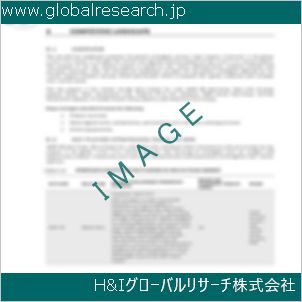Table of Contents
1 Industry Overview of Carbondisulfide
1.1 Definition and Specifications of Carbondisulfide
1.1.1 Definition of Carbondisulfide
1.1.2 Specifications of Carbondisulfide
1.2 Classification of Carbondisulfide
1.3 Applications of Carbondisulfide
1.3.1 Nuclear Application
1.3.2 Non-Nuclear Application
1.4 Industry Chain Structure of Carbondisulfide
1.5 Industry Overview and Major Regions Status of Carbondisulfide
1.5.1 Industry Overview of Carbondisulfide
1.5.2 Global Major Regions Status of Carbondisulfide
1.6 Industry Policy Analysis of Carbondisulfide
1.7 Industry News Analysis of Carbondisulfide
2 Manufacturing Cost Structure Analysis of Carbondisulfide
2.1 Raw Material Suppliers and Price Analysis of Carbondisulfide
2.2 Equipment Suppliers and Price Analysis of Carbondisulfide
2.3 Labor Cost Analysis of Carbondisulfide
2.4 Other Costs Analysis of Carbondisulfide
2.5 Manufacturing Cost Structure Analysis of Carbondisulfide
2.6 Manufacturing Process Analysis of Carbondisulfide
3 Technical Data and Manufacturing Plants Analysis of Carbondisulfide
3.1 Capacity and Commercial Production Date of Global Carbondisulfide Major Manufacturers in 2023
3.2 Manufacturing Plants Distribution of Global Carbondisulfide Major Manufacturers in 2023
3.3 R&D Status and Technology Source of Global Carbondisulfide Major Manufacturers in 2023
3.4 Raw Materials Sources Analysis of Global Carbondisulfide Major Manufacturers in 2023
4 Capacity, Production and Revenue Analysis of Carbondisulfide by Regions, Types and Manufacturers
4.1 Global Capacity, Production and Revenue of Carbondisulfide by Regions 2019-2024
4.2 Global and Major Regions Capacity, Production, Revenue and Growth Rate of Carbondisulfide 2019-2024
4.3 Global Capacity, Production and Revenue of Carbondisulfide by Types 2019-2024
4.4 Global Capacity, Production and Revenue of Carbondisulfide by Manufacturers 2019-2024
5 Price, Cost, Gross and Gross Margin Analysis of Carbondisulfide by Regions, Types and Manufacturers
5.1 Price, Cost, Gross and Gross Margin Analysis of Carbondisulfide by Regions 2019-2024
5.2 Price, Cost, Gross and Gross Margin Analysis of Carbondisulfide by Types 2019-2024
5.3 Price, Cost, Gross and Gross Margin Analysis of Carbondisulfide by Manufacturers 2019-2024
6 Consumption Volume, Consumption Value and Sale Price Analysis of Carbondisulfide by Regions, Types and Applications
6.1 Global Consumption Volume and Consumption Value of Carbondisulfide by Regions 2019-2024
6.2 Global and Major Regions Consumption Volume, Consumption Value and Growth Rate of Carbondisulfide 2019-2024
6.3 Global Consumption Volume and Consumption Value of Carbondisulfide by Types 2019-2024
6.4 Global Consumption Volume and Consumption Value of Carbondisulfide by Applications 2019-2024
6.5 Sale Price of Carbondisulfide by Regions 2019-2024
6.6 Sale Price of Carbondisulfide by Types 2019-2024
6.7 Sale Price of Carbondisulfide by Applications 2019-2024
6.8 Market Share Analysis of Carbondisulfide by Different Sale Price Levels
7 Supply, Import, Export and Consumption Analysis of Carbondisulfide
7.1 Supply, Consumption and Gap of Carbondisulfide 2019-2024
7.2 Global Capacity, Production, Price, Cost, Revenue, Supply, Import, Export and Consumption of Carbondisulfide 2019-2024
7.3 USA Capacity, Production, Price, Cost, Revenue, Supply, Import, Export and Consumption of Carbondisulfide 2019-2024
7.4 EU Capacity, Production, Price, Cost, Revenue, Supply, Import, Export and Consumption of Carbondisulfide 2019-2024
7.5 China Capacity, Production, Price, Cost, Revenue, Supply, Import, Export and Consumption of Carbondisulfide 2019-2024
7.6 Japan Capacity, Production, Price, Cost, Revenue, Supply, Import, Export and Consumption of Carbondisulfide 2019-2024
8 Major Manufacturers Analysis of Carbondisulfide
8.1 Manufacturer One
8.1.1 Company Profile
8.1.2 Product Picture and Specifications
8.1.2.1 Type I
8.1.2.2 Type II
8.1.2.3 Type III
8.1.3 Capacity, Production, Price, Cost, Gross and Revenue
8.1.4 Contact Information
8.2 Manufacturer Two
8.2.1 Company Profile
8.2.2 Product Picture and Specifications
8.2.2.1 Type I
8.2.2.2 Type II
8.2.2.3 Type III
8.2.3 Capacity, Production, Price, Cost, Gross and Revenue
8.2.4 Contact Information
8.3 Manufacturer Three
8.3.1 Company Profile
8.3.2 Product Picture and Specifications
8.3.2.1 Type I
8.3.2.2 Type II
8.3.2.3 Type III
8.3.3 Capacity, Production, Price, Cost, Gross and Revenue
8.3.4 Contact Information
8.4 Manufacturer Four
8.4.1 Company Profile
8.4.2 Product Picture and Specifications
8.4.2.1 Type I
8.4.2.2 Type II
8.4.2.3 Type III
8.4.3 Capacity, Production, Price, Cost, Gross and Revenue
8.4.4 Contact Information
8.5 Manufacturer Five
8.5.1 Company Profile
8.5.2 Product Picture and Specifications
8.5.2.1 Type I
8.5.2.2 Type II
8.5.2.3 Type III
8.5.3 Capacity, Production, Price, Cost, Gross and Revenue
8.5.4 Contact Information
…
9 Marketing Trader or Distributor Analysis of Carbondisulfide
9.1 Marketing Channels Status of Carbondisulfide
9.2 Traders or Distributors with Contact Information of Carbondisulfide by Regions
9.3 Ex-work Price, Channel Price and End Buyer Price Analysis of Carbondisulfide
9.4 Regional Import, Export and Trade Analysis of Carbondisulfide
10 Industry Chain Analysis of Carbondisulfide
10.1 Upstream Major Raw Materials Suppliers Analysis of Carbondisulfide
10.1.1 Major Raw Materials Suppliers with Contact Information Analysis of Carbondisulfide
10.1.2 Major Raw Materials Suppliers with Supply Volume Analysis of Carbondisulfide by Regions
10.2 Upstream Major Equipment Suppliers Analysis of Carbondisulfide
10.2.1 Major Equipment Suppliers with Contact Information Analysis of Carbondisulfide
10.2.2 Major Equipment Suppliers with Product Pictures Analysis of Carbondisulfide by Regions
10.3 Downstream Major Consumers Analysis of Carbondisulfide
10.3.1 Major Consumers with Contact Information Analysis of Carbondisulfide
10.3.2 Major Consumers with Consumption Volume Analysis of Carbondisulfide by Regions
10.4 Supply Chain Relationship Analysis of Carbondisulfide
11 Development Trend of Analysis of Carbondisulfide
11.1 Capacity, Production and Revenue Forecast of Carbondisulfide by Regions and Types
11.1.1 Global Capacity, Production and Revenue of Carbondisulfide by Regions 2024-2029
11.1.2 Global and Major Regions Capacity, Production, Revenue and Growth Rate of Carbondisulfide 2024-2029
11.1.3 Global Capacity, Production and Revenue of Carbondisulfide by Types 2024-2029
11.2 Consumption Volume and Consumption Value Forecast of Carbondisulfide by Regions, Types and Applications
11.2.1 Global Consumption Volume and Consumption Value of Carbondisulfide by Regions 2024-2029
11.2.2 Global and Major Regions Consumption Volume, Consumption Value and Growth Rate of Carbondisulfide 2024-2029
11.2.3 Global Consumption Volume and Consumption Value of Carbondisulfide by Types 2024-2029
11.2.4 Global Consumption Volume and Consumption Value of Carbondisulfide by Applications 2024-2029
11.3 Supply, Import, Export and Consumption Forecast of Carbondisulfide
11.3.1 Supply, Consumption and Gap of Carbondisulfide 2024-2029
11.3.2 Global Capacity, Production, Price, Cost, Revenue, Supply, Import, Export and Consumption of Carbondisulfide 2024-2029
11.3.3 USA Capacity, Production, Price, Cost, Revenue, Supply, Import, Export and Consumption of Carbondisulfide 2024-2029
11.3.4 EU Capacity, Production, Price, Cost, Revenue, Supply, Import, Export and Consumption of Carbondisulfide 2024-2029
11.3.5 China Capacity, Production, Price, Cost, Revenue, Supply, Import, Export and Consumption of Carbondisulfide 2024-2029
11.3.6 Japan Capacity, Production, Price, Cost, Revenue, Supply, Import, Export and Consumption of Carbondisulfide 2024-2029
12 New Project Investment Feasibility Analysis of Carbondisulfide
12.1 New Project SWOT Analysis of Carbondisulfide
12.2 New Project Investment Feasibility Analysis of Carbondisulfide
13 Conclusion of the Global Carbondisulfide (CAS 75-15-0) Industry 2024 Market Research Report
| ※参考情報 二硫化炭素(Carbondsulfide、CAS番号75-15-0)は、化学式CS2で表される無機化合物です。この化合物は、炭素と硫黄から構成されており、無色の液体として存在します。独特の甘い臭いが特徴で、揮発性があり、常温では比較的安定していますが、高温や還元環境では分解することがあります。二硫化炭素は、主に工業用途で広く使用されており、その特性や用途にはいくつかの重要な側面があります。 二硫化炭素は、化学的には極性を持たない分子であり、非極性溶媒としての性質があります。このため、脂溶性物質を溶解する能力があります。さらに、CS2は、非常に低い粘度を持ち、高い揮発性があり、これらの特性は主に工業プロセスにおいて非常に便利なものとなっています。 二硫化炭素の用途は多岐にわたります。その中でも最も一般的なのは、レーヨンやビスコース繊維の製造です。これらの繊維は衣料品に広く使用され、CS2はその製造プロセスで重要な溶媒として機能します。また、二硫化炭素は、硫化物の合成や農薬の製造、さらには石油精製プロセスにおける溶媒としても利用されています。 さらに、化学工業においては、二硫化炭素は炭素源としても利用されることがあります。例えば、CS2は二硫化物や硫黄系化合物の合成に用いられ、これにより様々な有機化学反応が促進されます。これにより、新しい化合物の開発や、特定の化学製品の製造が可能になります。 二硫化炭素はその化学特性から、毒性を持つことが知られています。CS2の蒸気を吸引すると、頭痛、めまい、神経障害、さらには肝臓や腎臓に対する影響が出る可能性があります。したがって、使用時には適切な安全対策が必要です。工業現場では、適切な換気や防護具の着用が奨励されており、環境中での規制も一般的に適用されています。 関連技術として、二硫化炭素の生産方法も重要な側面の一つです。一般的には、硫黄と炭素源を反応させることで生成されます。この反応は高温で行われるため、高温下での燃焼反応や還元反応を利用することが多いです。また、CS2を生成する新しい方法や反応の開発も進行しており、より効率的で環境に優しい製造プロセスの確立が求められています。 また、二硫化炭素は食品産業においても使用されることがあります。特に、農薬や防疫剤の成分として利用されることがあり、これにより作物を害虫や病気から守ることができます。ただし、農業用途でもその毒性を考慮する必要があり、適切な使用量や適用方法が求められています。 最後に、二硫化炭素は環境への影響も注視されており、工業的生産や使用に伴う排出管理が重要な課題となっています。適切な処理がなされない場合、大気汚染や水質汚染につながる可能性があり、これに対処するための技術や規制の強化が必要です。 以上のように、二硫化炭素は多様な用途や特性を持ち、化学工業や農業など様々な分野で重要な役割を果たしていますが、その取り扱いには慎重さが求められます。研究や技術の進展が進む中で、二硫化炭素の利用方法は今後も進化し続けることでしょう。 |
❖ 免責事項 ❖
http://www.globalresearch.jp/disclaimer












